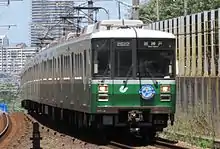Seishin-Yamate Line
The Seishin-Yamate Line (西神山手線, Seishin-Yamate-sen), also known by its nickname of "Midori no U-Line" (Japanese: みどりのUライン, lit. 'The green "U" line'), is one of the two lines of the Kobe Municipal Subway. It links the central districts to the east and western suburbs of Kobe. The line color is green.
| Seishin-Yamate Line | |||
|---|---|---|---|
 | |||
 A 6000 series train in 2021 | |||
| Overview | |||
| Other name(s) | Midori no U-Line | ||
| Native name | 西神山手線 | ||
| Status | Operational | ||
| Owner | Kobe Municipal Transportation Bureau | ||
| Locale | Kobe | ||
| Termini | |||
| Stations | 16 | ||
| Service | |||
| Type | Rapid transit | ||
| System | |||
| Operator(s) | Kobe Municipal Transportation Bureau | ||
| History | |||
| Opened | 13 March 1977 | ||
| Technical | |||
| Line length | 22.7 km (14.1 mi) | ||
| Number of tracks | 2 | ||
| Track gauge | 1,435 mm (4 ft 8+1⁄2 in) standard gauge | ||
| Electrification | 1,500 V DC overhead catenary | ||
| Operating speed | 90 km/h (55 mph)[1] | ||
| |||
Service pattern
The line has a reciprocal through service with the Hokushin Line (formerly the Hokushin Kyukuo Electric Railway); all trains run between either Tanigami or Shin-Kobe and Seishin-chūō, stopping at every station. During rush hours, additional trains run between Shin-Kobe and Myōdani.
History
On 15 October 1971, a railway license was issued to the Kobe Municipal Transportation Bureau to build a subway line linking the Myōdani district to the Shin-Kobe Shinkansen station; construction on the first segment of that line began on 25 November of that year. The first segment of the subway (between Shin-Nagata and Myodani, known as the Seishin Line) opened on 13 March 1977; a second segment of the line (between Shin-Nagata and Okurayama, known as the Yamate Line) opened on 17 February 1982. The line was extended to Shin-Kobe on 18 June 1985; a western extension to Gakuen-toshi (from Myodani) opened that same day. On 18 March 1987, the final segment of the subway line opened between Gakuen-toshi and Seishin-chūō.
The Hokushin Kyuko Electric Railway opened on 2 April 1988, providing service between Tanigami and Shin-Kobe. An infill station (Seishin-minami) opened in between Seishin-chūō and Ikawadani stations on 20 March 1993, expanding the line to a total of 16 stations. On 17 January 1995, the subway line was shut down due to damage caused by the Great Hanshin earthquake; the line resumed operation with limited service between Seishin-chūō and Itayado the following day, along with the entirety of the Hokushin Kyuko line. Limited service was resumed across the entire line on 16 February, and full service was restored in March 1995 after repairs were completed, albeit with speed restrictions remaining in place until 21 July of that year.
The subway began to accept the Surotto Kansai smart card in October 1999; it would start accepting PiTaPa in October 2006.
Women-only cars began to be used on the subway line from 16 December 2002. Currently, one car heading in the direction of Seishin-chūō (car number 4) is reserved for women only; the restriction applies throughout the entire day.
| Women-only car | |||||||
| ←Seishin-chūō | Shin-Kobe Tanigami→ | ||||||
| |||||||
Stations
| Name | No. | Name | Japanese | Distance (km) from Shin-Kobe |
Transfers | Location |
|---|---|---|---|---|---|---|
| Hokushin Line | S01 | Tanigami | 谷上 | –7.5 | Shintetsu Arima Line |
Kita-ku |
| Seishin-Yamate Line | S02 | Shin-Kobe | 新神戸 | 0.0 | Chuo-ku | |
| S03 | Sannomiya | 三宮 | 1.3 | |||
| S04 | Kenchōmae | 県庁前 | 2.2 | |||
| S05 | Ōkurayama | 大倉山 (湊川神社前) |
3.3 | |||
| S06 | Minatogawa-Kōen | 湊川公園 (川崎病院前) |
4.3 | Hyōgo-ku | ||
| S07 | Kamisawa | 上沢 | 5.3 | |||
| S08 | Nagata (Nagatajinjamae) | 長田(長田神社前) | 6.1 | Kobe Kosoku Line (Kosoku-Nagata Station) | Nagata-ku | |
| S09 | Shin-Nagata | 新長田(鉄人28号前) | 7.6 |
| ||
| S10 | Itayado | 板宿 (滝川中学・高等学校前) |
8.8 | Sanyo Railway Main Line | ||
| S11 | Myōhōji | 妙法寺 | 11.7 | Suma-ku | ||
| S12 | Myōdani | 名谷 | 13.3 | |||
| S13 | Sōgō Undō Kōen | 総合運動公園 | 15.1 | |||
| S14 | Gakuen-Toshi | 学園都市 | 16.8 | Nishi-ku | ||
| S15 | Ikawadani | 伊川谷 | 18.4 | |||
| S16 | Seishin-Minami | 西神南 | 20.1 | |||
| S17 | Seishin-Chuo | 西神中央 | 22.7 |
Rolling stock



- 1000 series (since 1977) (18 sets)
- 2000 series (1988–2022) (4 sets)
- 3000 series (1992–2021) (6 sets)
- 6000 series (since 2019) (25 sets)
- Hokushin Kyuko Railway 7000 series (since 1988) (5 sets)
All trains are based at Tanigami and Myōdani Depots.
A fleet of new trains (known as the 6000 series) is to be introduced on the line between fiscal 2018 and 2022; these trains will replace all existing trains on the line. Built by Kawasaki, the design of the new trains will be overseen by Ken Okuyama Design.[2]
The last of the 2000 series sets were retired in March 2021.[3]
See also
References
- Terada, Hirokazu (19 January 2013). データブック日本の私鉄 [Databook: Japan's Private Railways] (in Japanese). Japan: Neko Publishing. p. 154. ISBN 978-4-7770-1336-4.
- 神戸市交通局,新形車両デザインのデザイン案を公開 [Kobe Municipal Transportation Bureau publishes proposed designs for new trains]. Japan Railfan Magazine Online (in Japanese). Japan: Koyusha Co., Ltd. 17 October 2016. Archived from the original on 17 October 2016. Retrieved 17 October 2016.
- "神戸市営地下鉄2000形が引退、1000形を基本にデザイン性高めた車両". MyNavi Corporation (in Japanese). 12 April 2022. Retrieved 22 November 2022.
